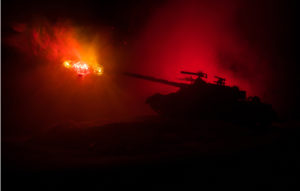The Russian Army could soon be invisible to 95% of NATO UAVs, thanks to a new camouflage nicknamed “Chameleon.” The system was developed by Ruselectronics, and is made up of small plates with an electrochromic coating. It can copy not only the color of the surrounding environment but also its structure. Grigory Voevodin of Russia Beyond writes (abridged):
The new camouflage technology has been nicknamed Chameleon. It is based on so-called electrochromic “glass” that consists of composite materials and changes color and transparency when an electrical current is applied.
The first prototypes of such an electrochromic coating for the battlesuit of the soldier of the future, the Ratnik, were demonstrated at the Army-2018 international military and technical forum in Russia. And, in early October 2021, RIA Novosti news agency, citing a source in the defence-industrial complex, reported that the new camouflage system was already being tested on mock-ups of armored hardware.
The camouflage works as follows: The exterior of an armored vehicle is completely covered with small electrochromic plates, each of which is connected to electric wires. Using video cameras, the system scans the entire surroundings. In parallel, it analyzes the colors and structure of the landscape and issues instructions for the coating to create a new camouflage image that will allow the vehicle to completely blend in with the terrain when seen from different angles.
The principle is borrowed from wildlife – chameleons or octopuses change their skin color to imitate the surface on which they find themselves. For example, if an octopus moves from a dark spot on the seabed to a lighter one, it quickly changes the color and texture of its skin coloring.
“This technology is not new – it has been used in the civilian sphere for a long time. It is the so-called smart glass that is sometimes installed in ‘meeting rooms’ in an office. When a meeting room is free, the glass is clear but, when it is occupied, it becomes tinted. But, there is certainly innovation in this military development. Such a coating is expected to quickly create a camouflage that mimics the landscape as accurately as possible, to be resistant to aggressive environmental factors and be reliable and cheap,” says Denis Fedutinov, editor-in-chief of Unmanned Aviation magazine.
According to Fedutinov, the large-scale fitting of ground-based Russian army hardware with such “capes” will render about 95 percent of unmanned aerial vehicles (UAVs) of a potential enemy practically obsolete when it comes to detecting them.
“The majority of reconnaissance UAVs belong to the class of small drones. They don’t have hardware for processing and analyzing incoming video information, either on board or in ground control systems. Data analysis is carried out directly by the drone operator, i.e. a human. It will be really difficult to detect and identify hardware disguised with the special coating,” Fedutinov explains.
According to the expert, the chameleon-like coating can be particularly effective bearing in mind that reconnaissance UAVs try to maintain a sufficient distance from an enemy so as to remain undetected themselves.
However, Chameleon won’t be a complete panacea for the protection of Russian military hardware, because it will only create a problem for simple reconnaissance drones (even if they do make up about 95 percent of all existing UAVs). If a drone is capable of simultaneously using reconnaissance equipment operating in different wavebands, then this will significantly reduce the effectiveness of Chameleon.
Also, the coating is capable of confusing only those enemy weapons equipped with TV-based optical homing heads. “For such missiles, auto lock-on can be disrupted through the use of the electrochromic coating. Furthermore, this applies both to homing heads using the photo contrast method and ones that remember the image of the target,” the expert points out.
Steve Schneider
Latest posts by Steve Schneider (see all)
- New Chinese Electromagnetic Surveillance Leaves “Nowhere to Hide” on Battlefield - March 15, 2024
- Amazon’s Nuclear Powered Data Center - March 7, 2024
- Skunk Works Rolls Out An Engineering Marvel - March 6, 2024
- Future of Airpower Takes First Flight - March 4, 2024
- A War Beneath the Waves – Trillions of Dollars at Stake - February 9, 2024















